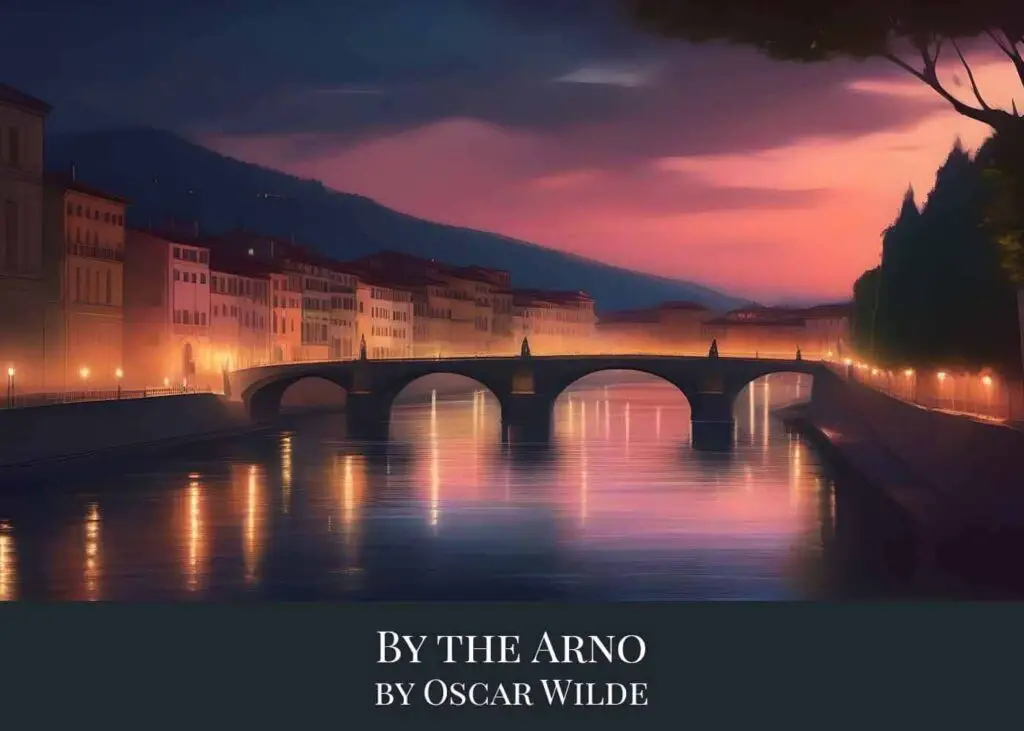
By the Arno by Oscar Wilde
“By the Arno” is a captivating poem by Irish dramatist and poet Oscar Wilde. Set against the backdrop of the Arno River in Florence, Italy, “By the Arno” is imbued with rich imagery and evocative language, reflecting themes of beauty, change, and the ephemeral nature of life. This particular poem is part of Wilde’s poetry collection Poems. For those interested in exploring more of Wilde’s poetic genius, the Poems online book is available at PageVio.
1. The Poem
The oleander on the wall
Grows crimson in the dawning light,
Though the grey shadows of the night
Lie yet on Florence like a pall.
The dew is bright upon the hill,
And bright the blossoms overhead,
But ah! the grasshoppers have fled,
The little Attic song is still.
Only the leaves are gently stirred
By the soft breathing of the gale,
And in the almond-scented vale
The lonely nightingale is heard.
The day will make thee silent soon,
O nightingale sing on for love!
While yet upon the shadowy grove
Splinter the arrows of the moon.
Before across the silent lawn
In sea-green vest the morning steals,
And to love’s frightened eyes reveals
The long white fingers of the dawn
Fast climbing up the eastern sky
To grasp and slay the shuddering night,
All careless of my heart’s delight,
Or if the nightingale should die.

Size: 8″ x 12″ (2:3 ratio)
Format: PDF
Copyright information: For personal use only
Note: Actual poster background color is white. For the sample poster, the background is made gray for illustration purpose.
2. By the Arno Analysis
Let’s analyze “By the Arno” stanza by stanza:
First Stanza
The poem opens with a vivid image: an oleander plant growing against a wall in Florence, Italy. The oleander’s crimson color is highlighted by the dawn’s light, contrasting with the lingering grey shadows of the night, described metaphorically as a “pall” (a cloth spread over a coffin, here symbolizing darkness covering the city). This stanza sets a scene of transition from night to day, with the emphasis on the beauty and vibrancy of the early morning.
Second Stanza
The focus shifts to a hill, where the morning dew and blossoms are bright and lively. However, there’s a sense of loss or change as the grasshoppers, symbols of summer and warmth, have gone, and the “little Attic song” (likely a reference to a type of music or bird song from ancient Athens) has ceased. This stanza suggests a change in seasons or a passage of time, evoking a feeling of nostalgia or melancholy.
Third Stanza
Here, the scene becomes calmer and more serene. The only movement is the gentle stirring of leaves by a soft breeze. The poet mentions an “almond-scented vale,” adding a sensory experience to the imagery, and notes the solitary song of a nightingale. This stanza creates a peaceful, solitary atmosphere, possibly suggesting loneliness or contemplation.
Fourth Stanza
The poet addresses the nightingale directly, acknowledging the approaching day which will silence its song. The nightingale is urged to continue singing for love, even as the moon’s light begins to fade and dawn approaches. This stanza could be interpreted as a metaphor for holding onto moments of beauty or love, even as change is inevitable.
Fifth Stanza
The dawn is personified as it approaches, described wearing a “sea-green vest.” The morning light is depicted as revealing “the long white fingers of the dawn,” an image that might represent the rays of sunlight. This stanza continues the theme of the inevitable arrival of morning, with a sense of something beautiful yet overwhelming about the dawn.
Sixth Stanza
The final stanza speaks to the relentless advance of the day, climbing the sky to overtake the night. There is a sense of indifference to the poet’s personal feelings (“All careless of my heart’s delight”) and a concern for the fate of the nightingale. The poem concludes with a reflection on the relentless nature of time and change, and perhaps a hint of sorrow for the things lost in its wake, like the nightingale’s song.
Throughout the poem, there’s a strong theme of transition and the contrast between night and day, with a focus on natural beauty and a sense of melancholy for things that are passing or changing.
3. Conclusion
If you find pleasure in “By the Arno,” you may want to delve into our list of poems by Oscar Wilde.




